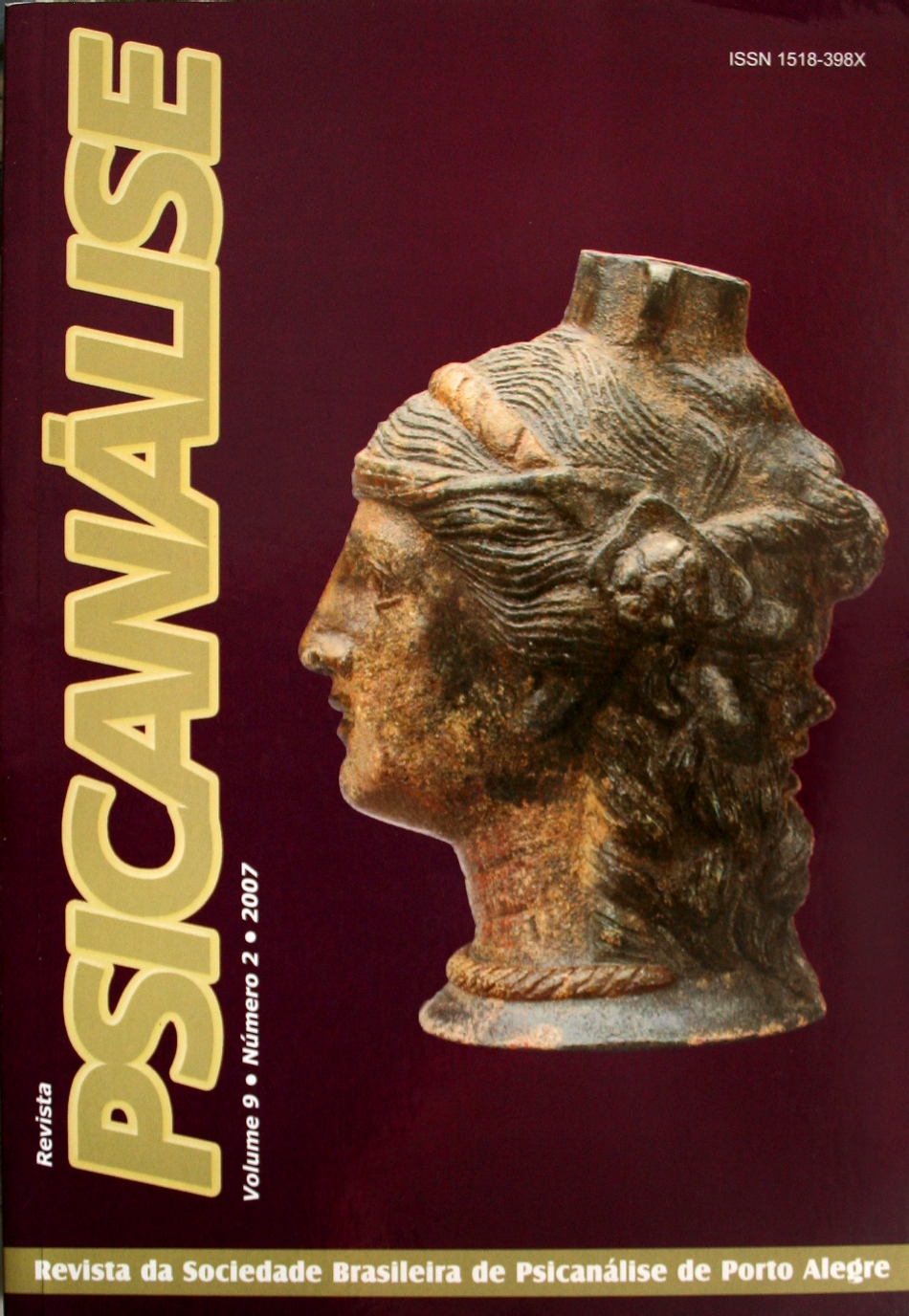The Observation Method of Children Esther Bick, psychanalyze of children and teenagers
ateliê privileged to contemporary psychoanalyse
DOI:
https://doi.org/10.60106/rsbppa.v9i2.259Keywords:
The theorical and technical conquers of the children, teenagers and the Esther Bick Babies Observation Method, The essence of the psychoanalytical Method, The theorical and technical demands of the present clinic, The Primitive States of Mind, The place of the analyst revisited, “Para- transferring”, Analytical functions, The new pathologiesAbstract
The psychoanalysis of children, of teenage patients and also the Esther Bick method of infant Observation Method can enlighten the reformulations of technical and theoretical issues of the new diseases of the soul. In these pathological cases, the failure or the non existence of representations is the maim issue. The best contributions are: I) The understanding of the essence of the psycoanalitycal method and its consequences in the technical process; II) The metapsychological understanding of the Primitive States of Mind; III) The analyst’s function revisited fa beyond the interpretative function; IV) The “paratransferências”; V) A new conception of psychoanalytic training; Melanie Klein created a new technique which foundation is a new metapsychology. a) The analyst reaches the patient in his structural level; b) The patient can be what he is. The analyst goes over the infant world and does not pull off the patient for him to reach the traditional theoretical and technical foundations; c) In the context the birth of the subjectivity is accepted; d) Differently from Hans’case, sometimes the mind needs to be built from the beginning; e) The conquer of language can be the final aim of the analysis and not necessary be a precondition for the beginning of the process .
Downloads
References
ALVAREZ, A. (1992). Live company. London: Tavistock Clinic, 1992.
BARANGER, W. e BARANGER, M. (1969). Problemas del campo psicoanalítico. Buenos Aires: Ed. Kargieman, 1993.
BLEICHMAR, H. (1997). Avances en psicoterapia psicoanalítica. Buenos Aires: Paidós, 1999.
BIANCHEDI, E. T. et al. (1999). Bion, conocido / desconocido. Buenos Aires: Lugar Editorial, 1999.
BIANCHEDI, E. T. e SOR, D. La mente primordial, el mito de Babel, y la mente separada. In: SIMPÓSIO DA APdeBA, 5., 1993, Buenos Aires. Anais... Buenos Aires: APdePA, 1993.
BICK, E. (1962). Chil analysis today. International Journal Psychoal, London, v. 43, pt. 4-5, p. 238-332, 1962.
_____. (1968). A experiência da pele em relações arcaicas. In: ______. Melaine Klein hoje. Rio de Janeiro: Imago, v. 1, p. 194-198, 1991.
BION, W. (1978). Clinical Seminars: São Paulo 1978. In: CLINICAL SEMINARES AND FOUR PAPERS. Fleetwood, 1987.
BLEGER, J. (1967). Psicoanálisis del encuadre psicoanalítico. In: ______. Simbiosis y ambiguidad: estúdio psicoanalítico. Buenos Aires: Paidós, 1967, p. 237-250.
FREUD, A. (1927). Psicoanálisis del niño. Buenos Aires: Hormé, 1964.
FREUD, S. (1909). Apéndice al análisis del pequeño Hans. In: ______. Obras completas. Buenos Aires: Amorrortu, 1922. vol. 10.
_____. (1913). La predisposición a la neurosis obsesiva: contribución al problema de la elección de neurosis. In: ______. Obras completas. Buenos Aires: Amorrortu, 1976. vol. 12.
GREEN, A. (1997). Un psicoanalista comprometido: conversaciones com Manuel Macias. Buenos Aires: Grupo Editorial Norma. 1997.
KANCYPER, L. (1994). El campo analítico con niños y adolescente. In:_____.Psicoanálisis de niños y adolescentes en América. Lima: FEPAL., 1994, p.158-165. vol. 1. Apresentado no 1º Congreso Latinoamericano de Psicoanálisis de Niños y Adolescentes, Córdoba, 21-25 abril 1994.
KLEIN, M. (1959). Our adult world and its roots in infancy. In: _____ Envy and gratitude and other works: 1946-1963. London: The Hogarth Press, 1980. p.247-63. (The Writings of Melanie Klein, 3).
KORBIVCHER, C.F. (2001). A teoria das transformações e os estados autísticos: transformações autísticas: uma proposta. Rev. Bras. Psicanál., v. 35 , n. 4 , p. 935-958, 2001.
LACAN, J. (1954). ¡El Lobo! ¡El Lobo!. In:_____. Le séminaire de Jacques Lacan. Livre 1. Paris: Éditions du Seuil, 1975.
LANDOLFI, P. (2004). Transferencia (T) y Contratransferencia (CT) en psicoanálisis de niños: el problema de la Paratrasnferencias (PT). In: CUARTO ENCUENTRO ASOCIACIÓN PSICOANALÍTICA ITALIANA: TRANSFERENCIA – CONTRATRANSFERÊNCIA HOY. Anais… Buenos Aires: Asociación Psiconalítica Argentina, 29 e 30 de Outubro de 2004. p. 76-78.
LUTEMBERG, J. (2001). Revisión del paradigma freudiano de la sexualidad: el vacio mental y la edición. In: Asociación Escuela Argentina de Psicoterapia para Graduados. Buenos Aires, n. 27, p. 113-138, 2001. Fundamentos del psicoanálisis: desarrollos teóricos, clínicos y técnicos.
MARUCCO, N.C. (1998). Cura analítica y transferencia: de la represión a la desmentida. Buenos Aires: Amorrortu, 1998.
MELTZER, D. (1967). The psycho-analytical process. London: William W. M. Books ltda, 1996.
MELTZER, D. et al. (1975). Exploración del autismo. Buenos Aires: Paidós, 1976.
MOGUILLANSKY, R. (1999). Vinculo y relacion de objeto. Buenos Aires: Polemos, 2003.
OGDEN, T.H. (1992). A fronteira primária da experiência humana. Madrid: Julian Yebenes, 1992.
WINNICOTT, D. W. (1963). Fear of breakdown. In: WINNICOTT, C. et al. Psycho-analytic explorations. London: Karnac Books, 1989. p.87-95.
ZYGOURIS, R. (2002). O vínculo inédito. São Paulo: Escuta, 2002.
Downloads
Published
How to Cite
Issue
Section
License
I attribute the copyrights that belong to me, on this work, to SBPdePA, which may use and publish it by the means it deems appropriate, including on the Internet or in any other computer processing.
















